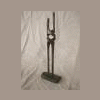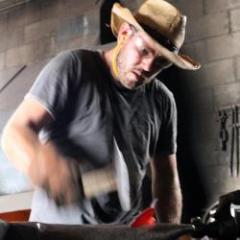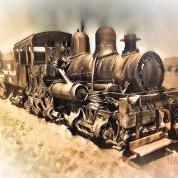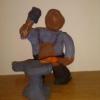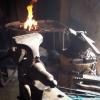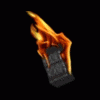-
Posts
2,607 -
Joined
-
Last visited
Contact Methods
-
MSN
teewelder@msn.com
-
Website URL
http://www.turleyforge.com
Profile Information
-
Gender
Male
-
Location
Santa Fe, New Mexico
-
Interests
American Indian dancing/singing
Cowboy culture and horsemanship
Horseshoeing
Traditional Hispanic ironwork, esp, hardware
tai chi chuan and chi kung
Converted
-
Location
Santa Fe, NM
-
Interests
Cowboys and Indians
-
Occupation
instructor blacksmithing
Recent Profile Visitors
-
jimmymo5 started following Frank Turley
-
I've been known to arc weld pieces of mild steel together for short-run monkeys.
-
This steel feather was made by Doug Wilson of Little Deer Isle, Maine. I think he folded it lengthwise to have the quill standing proud. He didn't try for the angled effect coming off the quill, but rather forged the feather flat and fairly thin. The quill outlines on the obverse look as though they might have been set down with a set hammer; they are very clean workmanship. The shape of the feather is important and well done. It's a tail feather and I've put next to it a turkey feather painted and disguised to be an eagle feather. I think Doug rolled and forge welded the quill end, but I wasn't there when he made it.
-
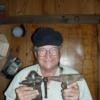
You guessed it, another tong material question!
Frank Turley replied to Ranchmanben's topic in Tongs
I've made lots of farrier's tongs for sale. I used A36 which is sometimes named "mild steel." None of the tongs were returned, and the reins all had spring. Some had forge welded reins, some didn't. A more respectable steel should be selected if making large industrial tongs, for example 4140 or 1080, and with no forge welded reins. A tenet in blacksmithing is to NOT let your tong jaws get an incandescent heat. The only exception I can think of is to heat the tong jaws if they are to grab tool steel to be quenched, thereby not withdrawing any heat from the tool steel. -

Fuel in medieval times
Frank Turley replied to Dez Moore's topic in Solid Fuels: Coal, Coke, Charcoal, Wood, etc
Charcoal was made in large amounts for the Iron Furnaces by carefully making a circular mound of wood, The method is described in the book, "Frontier Iron." The workers were called colliers. -
Dogwood is a good mallet head; no flash and it lasts a long time. Give this a try. squeeze the bent twist in the vise keeping the work corner to corner facing the vise jaws, the untwisted portion that you're holding. Give it a turn and squeeze again. The twist is wider than the parent stock, because corner to corner measures more than flat to flat.
-
I've made a few and taper the business end down to about 1/8" D on the end, and I make the end hemispherical. If the horse should move suddenly, the is little chance of cutting, scraping of gouging.
-
Given that a person has decent physical and mental health, that person can learn many procedures and become good with time and practice. Geist brings up the subject of passion, which might also be termed "desire." I couldn't see desire in 10 minutes. Perhaps someone else could.
-
I started forging in the early 1960's, and my mentors all said, "leg vise." I think 8" jaws were considered max by most manufacturers. I'm fairly certain that some of the boxes and screws were cast in the U.S., thinking of Columbian and Iron City. They probably did not use gray cast iron, but rather something like semi-steel. I doubt that the jaws and bodies were ever cast. Good info is on anvilfire.com by clicking in the drop down menu 'FAQS' getting the alphabet and tuning in V for vises.
-
It would make a good claw hammer for carpentry, but you might heat treat the head and claw separately. leaving the eye normalized. The face of a 1045 forging hammer gets a "hard temper" of straw or dark straw. It will not get harder in use.
-
I was at a Francis Whitaker workshop once, and a guy said that when he started to collar his scrollwork, there wasn't enough room (daylight) to slip the collars on. Francis said, "Then your design is wrong." Now about this coil spring upset, is your design wrong from the git-go? Can't you use mild steel so you can quench without worrying about hardening? Something I heard a few years ago, "Never more than three." They were referring to the heat length being never more than three times the thickness or diameter of the stock you're upsetting.
-
Somebody told me this years ago. "Starting a business without capital is kind of like being the Butterscotch Man. You have to get warm in order to run, but you have to run in order to get warm." I am not a maker of butterscotch, but I get a kick out of this saying, nevertheless.
-
More than one of this style vise was made. About 35 years ago, our local "Fritz Surplus" in Santa Fe, brought back about a dozen of them from a buying trip. It seems that Columbians kept getting less aesthetically pleasing over time. The leg chamfering and pivot-beam chamfering are gone. Two rivets are reinforcing the pivot-beam weld. The vee-spring is not an improvement, as there is more throw to open the jaw than if it was a single spring, as of old. I suspect that the jaws were drop forged, although I see no die parting lines. I think the screw with screw head were cast as well as the box, but probably not cast iron, more likely semi-steel. I have a hunch this style of vise was World War II vintage. Some of the above is guess work on my part, having had quite a few leg vises go through my hands.
-

New to the Forge from Falcon, Colorado
Frank Turley replied to Jonathan Smidt's topic in Introduce Yourself
"Rocky Mountain Smiths" is a good group to join. -
H13 is delivered new as annealed, so if it a struck head tool like a pritchel, don't heat that end. Leave it annealed. The other, business end is heated to 1950 - 2100F (lemon or yellow colored) and forged, but not below 1650F (bright red). Anneal at 1550 -1650F (bright red) in wood ashes, builder's lime, or vermiculite (all insulators). Harden at a slow rising heat to 1825 - 1900F (orange color heat) and air cool in still air on a non reactive surface. Temper at 1000 - 1200F (dark red incandescent color); air cool..
-

Has anyone ever seen one of these tiny vises?
Frank Turley replied to IRON IKE IGNACIO's topic in Vises
A hand vise, fairly common in the old days. The vise-grips have pretty much replaced them.

